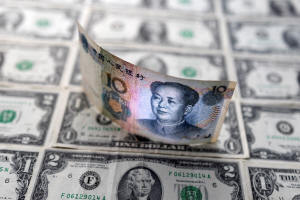Rouble slips again, Swiss franc hits seven-year high
 Send a link to a friend
Send a link to a friend
 [March 01, 2022] By
Elizabeth Howcroft [March 01, 2022] By
Elizabeth Howcroft
LONDON (Reuters) - The rouble fell further
on Tuesday after partly recovering some ground, while the dollar edged
higher and the Swiss franc hit a seven-year high, as investors sought
out the safe-haven currency while waiting for developments in Ukraine.
Financial markets have been rocked in recent days by Russia's invasion
of Ukraine, the biggest assault on a European state since World War Two,
and the resulting Western sanctions which include cutting off some
Russian banks from the SWIFT financial network and limiting Moscow's
ability to deploy its $630 billion of foreign reserves.
Global stock markets initially showed signs of regaining their composure
on Tuesday, but by 1152 GMT European indexes and Wall Street futures
were firmly in the red.
The rouble was down around 4% on the day, trading at 97.036 per dollar,
a day after it collapsed to a record low of 120 per dollar. Earlier on
Tuesday it had recovered some of those heavy losses, helped by an
emergency rate hike by Russia's central bank.
Still, the rouble was down almost 30% from its best levels this year.
The U.S. dollar, which surged last week on safe-haven flows, continued
to climb, leaving the dollar index up 0.2% at 96.96 .

The euro was down 0.4% on the day at $1.1175.
ROUBLE 'BAROMETER'
Neil Jones, head of FX sales at Mizuho, said that investors were
watching the rouble and using that to determine the direction of other
currencies.
"Rouble is the barometer which the rest of the foreign exchange market
follows right now," Jones said.
The safe-haven yen was around 0.2% stronger against the dollar, at
114.790 .
Meanwhile, the Swiss franc hit its strongest level since 2015 against
the euro, with the pair last at 1.0248.
Mizuho's Jones said some investors were disappointed that the yen had
been underperforming the Swiss franc as a safe-haven currency, and
suggested one reason may be that Japan has higher energy demands - and
buying energy involves selling the yen to buy dollars, which puts
depreciation pressure on its currency.
[to top of second column] |

Chinese yuan banknote is displayed on U.S. Dollar banknotes in this
illustration taken, February 14, 2022. REUTERS/Dado Ruvic/Illustration

The Swiss National Bank's sight deposits were little changed in February,
suggesting the central bank may have given up its attempts to slow the franc's
appreciation.
Currency volatility was at its highest since late 2020, as measured by a
Deutsche Bank index.
"Today, the focus will be on whether sanctions/retaliation will start impacting
the commodity flows from Russia, and whether (Russia's central bank) will step
in with more measures to support the rouble," ING FX analysts wrote in a note to
clients.
Among the G10 currencies, Sweden's crown, the euro and Britain's pound could
suffer the most if sanctions affect the flow of Russian gas into Europe, they
said, while Norway's crown may keep benefiting from high gas prices.
The Australian dollar hit its highest since mid-January in early trading, before
easing to trade up 0.1% on the day at $0.72715, its third consecutive day of
gains.
Australia's central bank on Tuesday held interest rates at a record low and
cited the war in Ukraine as a major new source of uncertainty as it stressed
patience on tightening policy.
The New Zealand dollar was steady at $0.67755 .
Some of the demand for Australian and New Zealand dollars may be due to
geography, with the countries far away from the troubles in Europe and little
exposed to Russian trade.
Bitcoin jumped sharply late on Monday to briefly hit a 12-day high above
$44,000.
(Reporting by Elizabeth Howcroft; Editing by Kirsten Donovan and Gareth Jones)
[© 2022 Thomson Reuters. All rights
reserved.]This material may not be published,
broadcast, rewritten or redistributed.
Thompson Reuters is solely responsible for this content.
 |